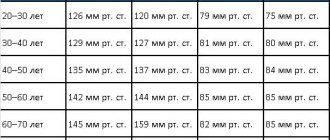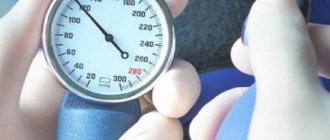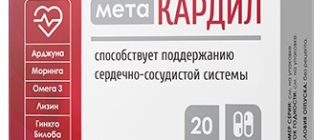Types of blood pressure
Blood pressure is a variable value; its normal values vary depending on heartbeat cycles, physical activity, emotional and hormonal fluctuations, and time of day. As a rule, the highest blood pressure numbers are recorded during daytime activity, the lowest during deep sleep at night.
Types of blood pressure:
- Systolic (upper) pressure. The maximum blood pressure on the walls of the arteries during systole is the contraction of the heart muscle of the right and left ventricles and the release of blood into the pulmonary trunk and aorta. Systolic pressure is the first digit in the blood pressure record.
- Diastolic (lower) pressure. The lowest level of blood pressure on the walls of blood vessels is during diastole - relaxation of the muscles of the atria and ventricles, during which the heart fills with blood. Depends on vascular resistance. The diastolic pressure numbers in the blood pressure record are in second place.
- Pulse pressure is the difference between systolic and diastolic pressure.
Can the signs of hypertension be recognized?
The insidiousness of the disease is that it does not make itself felt for a long time. A person with hypertension that has not been diagnosed by a doctor may feel well for quite a long time, while his heart muscle is already working at high pressure.
At the same time, experienced hypertensive patients can easily name the signs that accompany increased blood pressure. Experts do not call them symptoms of the disease, because, strictly speaking, they do not signal an increase in blood pressure, but a complicated course of the disease.
- The patient's vision deteriorates, headaches, and tinnitus occur.
- Decreased strength and sensation in one or both limbs.
- At rest, shortness of breath and dizziness occur.
- The daily urine output inexplicably decreases.
In case of undiagnosed hypertension of II and III degrees or when stopping taking antihypertensive, blood pressure-lowering drugs prescribed by a doctor, the patient may experience a hypertensive crisis, sharply exacerbating the symptoms of the disease. A significant surge in pressure is accompanied by:
- severe headache and chest pain;
- shortness of breath;
- vomiting;
- disturbances of consciousness and convulsions;
- paralysis and even death.
The only way to detect increased pressure is to measure it with specialized devices, tonometers. The gold standard for diagnosing arterial hypertension is 24-hour blood pressure monitoring performed under the patient’s usual conditions. Diagnosis is carried out using a specialized device attached to the body. It measures blood pressure levels day and night at a specified frequency, identifying “daytime” and “nighttime” hypertension. Often, based on the diagnostic results, the patient is prescribed a consultation with a cardiologist.
Medical normal blood pressure
Blood pressure is measured in millimeters of mercury (mmHg). Normal blood pressure levels vary depending on the age, weight and state of health of a person, but in general there are generally accepted standards, based on which the doctor can conduct an initial diagnosis, assess the patient’s well-being, the absence or presence of certain problems. Medical blood pressure standards are the same for men and women.
Medical pressure standards
| Category | Systolic blood pressure (mm Hg) | Diastolic blood pressure (mm Hg) |
| Optimal | up to 120 | up to 80 |
| Normal | 120-129 | 80-84 |
| High normal | 130-139 | 85-89 |
| Arterial hypertension stage 1. | 140-159 | 90-99 |
| Arterial hypertension stage 2. | 160-179 | 100-109 |
| Arterial hypertension stage 3. | from 180 and above | from 110 and above |
| Isolated systolic hypertension | more than 140 | less than 90 |
Diagnostic measures
To diagnose a pulse pressure disorder and the cause of its occurrence, you need to consult a therapist. The therapist will conduct a general examination and write a referral to a cardiologist, endocrinologist, neurologist, nephrologist. A comprehensive examination will help to accurately determine the cause of the deviation of pulse pressure from normal values. After a comprehensive examination, the doctor will prescribe appropriate treatment according to indications.
Diagnostic methods:
- neuromonitoring, checking the functioning of the kidneys and thyroid gland;
- physical diagnosis;
- collecting information about the development of the disease, concomitant diseases, and other abnormalities;
- measuring blood pressure using a tonometer;
- continuous recording of heart dynamics on ECG throughout the day;
- ECG;
- Ultrasound of the heart;
- Doppler examination of the vessels of the neck and head;
- analysis of thyroid hormones;
- Ultrasound of the kidneys;
- clinical urine analysis;
- general blood analysis;
- blood chemistry.
The types of diagnostic tests are determined by the attending physician after assessing the general condition of the patient.
ECG is one of the most accessible diagnostic methods
Monitoring and correction of blood pressure
Optimal and normal blood pressure does not require constant monitoring. For people with such blood pressure indicators, it is enough to measure it periodically, during routine medical examinations, medical examinations, and visits to the doctor for other reasons.
High normal blood pressure (HNBP) is not an independent disease or risk factor, but is considered as a condition in which early primary prevention of arterial hypertension and associated complications is possible. The maximum predisposition to high normal blood pressure is found in men aged 40 to 59 years with a high body mass index. They are advised to control blood pressure somewhat more often than standard recommendations, get rid of bad habits, and normalize weight.
Arterial hypertension of the 1st degree is often asymptomatic and remains undetected for a long time. If its signs are accidentally detected, for example, during a routine examination, the patient is recommended to undergo 24-hour blood pressure monitoring in order to exclude the “white coat” syndrome – increased blood pressure due to anxiety and fear of doctors. When the diagnosis is confirmed, the patient needs regular observation by a local doctor and periodic self-measurement of blood pressure. Arterial hypertension of the 1st degree does not always require pharmacological therapy. Often, lifestyle adjustments help stabilize blood pressure: proper nutrition and normalization of weight, giving up bad habits, moderate physical activity, and lack of stress.
In case of arterial hypertension of 2 and 3 degrees, isolated systolic hypertension, constant (most often daily) independent monitoring of blood pressure is required. To correct these conditions, in addition to lifestyle changes, drug therapy is required, which is carried out only as prescribed and under the supervision of a doctor.
Why does the resting heart rate increase at this level of blood pressure?
Increased heartbeat usually appears during physical overload, with sudden changes in blood pressure, due to stress. But it happens that the heart begins to beat faster even in a calm state, that is, tachycardia occurs.
Even with a pressure of 120 to 80, a pulse of 120 is a completely understandable phenomenon, for which there are many prerequisites. The prerequisites or provoking factors of tachycardia can be divided into physiological and pathological.
Physiological causes of tachycardia are much easier to eliminate, and in some cases, rapid heartbeat provoked by physiological factors simply goes away on its own.
Physiological tachycardia can occur:
- due to overeating;
- due to consumption of caffeine-containing products or energy drinks;
- due to excitement, anxiety;
- after being in a stuffy environment for a long time;
- when exposed to heat for a long time or in high mountain climates;
- at elevated body temperature.
Pathological causes are much more difficult to understand, since they are associated with certain diseases and require careful diagnosis. Their list includes:
- various pathologies of the heart and blood vessels;
- endocrine disorders - thyroid disease, adrenal hyperfunction;
- various anemias;
- pulmonary pathologies - emphysema, silicosis (a severe type of pneumoconiosis - an occupational pulmonary disease);
- intoxication;
- neuroses, psychoses, states of passion.
Pregnant women often complain of tachycardia in a calm state, most often from the middle of the second trimester, which is explained by the increased load on the body due to the enlargement of the fetus.
Tachycardia in pregnant women can become permanent, which is associated with changes in hormonal levels and compression of the diaphragm by the enlarged uterus. Women in this condition should be under the supervision of their attending physician.
In order not to cause unnecessary concern in patients, let us remind you that a person’s condition is considered normal if the pressure is 120 to 80, the pulse is up to 90. We will consider what to do if the pulse is much higher.
Blood pressure norms depending on gender and age
Blood pressure is higher in adults than in children; it differs between men and women. In women, changes in blood pressure are affected by pregnancy and menopause.
Blood pressure norms for men and women
Age (years) Systolic blood pressure (mm Hg) Diastolic blood pressure (mm Hg) male wives husband. wives 10-20 123 116 76 72 20-30 126 129 79 75 30-40 129 127 81 80 40-50 135 137 83 84 50-60 142 144 85 85 60-70 145 159 82 85 70- 80 147 157 82 83 80 -90 145 150 78 79Often young people under 35 years of age do not notice symptoms of high blood pressure. However, they can also develop arterial hypertension, so periodic monitoring in case of existing risk factors and the appearance of complaints is mandatory for timely diagnosis, prevention and treatment if necessary.
In childhood, the walls of blood vessels are more elastic, so normal blood pressure in children is lower than in adults. The indicator increases as the child grows. The most significant change in blood pressure values is observed from birth to one year. Girls and boys have the same blood pressure, the difference appears towards the end of puberty.
Blood pressure norms in children
| Age | Systolic blood pressure (mm Hg) | Diastolic blood pressure (mm Hg) |
| newborns | 60-96 | 40-50 |
| from 2 months up to a year | 80-112 | 50-74 |
| 1-2 years | 82-115 | 61-75 |
| 2-3 years | 85-116 | 60-76 |
| 3-4 years | 90-118 | 60-78 |
| 4-5 l. | 95-120 | 60-80 |
| 5-6 l. | 100-122 | 60-80 |
| 6-8 l. | 110-122 | 70-82 |
| 8-11 l. | 110-126 | 70-82 |
| 12-15 l. | 110-136 | 70-86 |
| 15-16 l. | 110-136 | 70-90 |
| 16-18 l. | 110-120 | 80-90 |
Diet is an important factor in the fight against high blood pressure
A healthy lifestyle can work wonders. Some reduction in systolic (upper reading) blood pressure can be achieved by increasing physical activity, losing excess weight, and changing your eating strategy.
- Sodium, which is the main component of table salt, negatively affects kidney function and contributes to an increase in diastolic (lower) pressure. Therefore, limiting salt to 5 grams daily helps normalize the levels. Try to gradually replace NaCl with spices and herbs that have a beneficial effect on the body. They promote the removal of toxins and suppress the growth of pathogenic microflora.
- Hypertensive patients with extra pounds are advised to limit the consumption of fats, smoked and fried foods, and easily digestible hydrocarbons (sweets, potatoes, etc.).
- Food should be taken several times a day in small portions, without overeating and giving preference to lean meat and fish, cereals, low-fat fermented milk products, vegetable and low-fat meat soups, fresh vegetables and fruits.
- Products with a high content of potassium and magnesium will be extremely useful - fresh apricots, dried apricots, apples, etc.
- It is very important to limit the consumption of alcohol, which reduces the effectiveness of antihypertensive drugs.
- The effect of caffeine on blood pressure has not been fully studied. But it is known that an increase in blood pressure by 5-10 points after a cup of coffee may indicate high sensitivity to caffeine. Therefore, you should not abuse the aromatic drink.
How to measure blood pressure correctly
A special device is used to measure blood pressure - a tonometer. Tonometers are manual (mechanical), semi-automatic and automatic.
Selecting a tonometer
The manual one consists of a shoulder cuff, an air pump (bulb), a stethoscope, and a pressure gauge. The semi-automatic tonometer contains a cuff, a bulb and an electronic unit. An automatic tonometer pumps air on its own and consists only of a cuff and an electronic unit.
It is difficult to measure pressure on your own with a manual tonometer; you will need the help of a person with the necessary skill. However, measurement with a manual tonometer is considered the most accurate. Most often it is used by doctors. Semi-automatic and automatic devices allow you to monitor blood pressure at home or at work without difficulty and outside assistance.
Rules for measuring blood pressure
To obtain the most accurate result, the following rules must be observed:
- the measurement should be carried out in a quiet environment, in a quiet room at room temperature;
- After eating, physical activity, smoking, at least 30 minutes must pass before the procedure;
- Do not drink tea or coffee before measurement;
- Blood pressure should be measured while sitting in a comfortable natural position, the hand should rest on a support approximately at the level of the heart, and be as relaxed as possible;
- During the measurement, you cannot keep your legs crossed, move or talk;
- Blood pressure should be measured on both arms with a break of 10-15 minutes;
- When taking antihypertensive drugs, 1-2 hours should pass before measuring blood pressure.
The results must be recorded in a special diary, noting the date, time of measurement, circumstances that may affect the result - poor sleep, malaise, taking medications.
How to relieve the condition at home?
If pulse pressure increases or decreases, you must call an ambulance. It is impossible to normalize the condition and help the patient at home.
Before the ambulance arrives, you must follow the general recommendations:
- You should not take pills for hypertension or hypotension without a doctor’s prescription; taking medications not according to indications can lead to a worsening of the condition; before prescribing medications, the doctor will conduct a comprehensive examination, determine the cause of the disease, the severity of the problem, and then draw up a therapeutic treatment plan;
- if pulse pressure is disturbed, the patient should not be allowed to drink or eat, this can lead to loss of consciousness and involuntary vomiting; in this state, the patient may choke on vomit;
- to normalize the condition, you need to take a comfortable position, calm down, take a few deep breaths and exhales, think about the good;
- in the room you need to open a window or window to ensure the flow of fresh air into the room, you need to remove tight clothes from your body, unfasten the collar.
Upon arrival of the ambulance team, you must describe your condition in detail, as well as follow all the recommendations of medical workers. Specialists will provide first aid and decide whether hospitalization is necessary.
How often should you measure your blood pressure?
If a person associates poor health with high blood pressure, to confirm this fact it is necessary to measure it for several days in a row, repeatedly during the day at approximately the same hours - usually in the morning and evening, unless a different frequency of measurements is recommended by the doctor. It is recommended to take 2-3 measurements at a time with an interval of 2-3 minutes.
Daily blood pressure measurements are also recommended in other cases. These include:
- first identified fact of increased blood pressure;
- changing the treatment regimen for arterial hypertension (changing drugs or their dosage);
- increased blood pressure during antihypertensive therapy;
- cardiovascular diseases, in addition to arterial hypertension;
- taking medications for other diseases that may affect blood pressure levels.
Causes of headaches with normal blood pressure
In most cases, headache is observed at values of 125 to 70 in patients for whom these parameters are not normal. One of the causes of pain can be hypoxia, when brain cells experience oxygen deficiency, aching pain localized in the occipital and temporal regions.
Headaches can be a manifestation of hypertonicity of the cervical muscles, which causes spasm of the blood vessels that supply nutrition to the brain
In hypertensive patients, headache occurs against the background of vascular spasm and circulatory disorders. The pain syndrome is shooting and aching in nature with localizations in the occipital, frontal and temporal regions with irradiation to the bridge of the nose.
Reasons for deviation of blood pressure from normal
Blood pressure numbers may be lower or higher than accepted norms. If changes in indicators are recorded repeatedly and are not associated with external influences (heat or cold, stress, physical activity before measurement) or malfunction of the tonometer, they speak of hypotension (low blood pressure) or hypertension (high blood pressure). Hypertension is diagnosed more often than hypotension; among the entire population, the ratio is about 40% and 5%, respectively.
Hypotension – decrease in blood pressure to 100/60 mm. rt. Art. and less. Accompanied by weakness, dizziness, drowsiness, sweating, shortness of breath, memory impairment.
Hypertension is a rise in blood pressure above 140/90 mm. rt. Art. Characterized by headache, dizziness, pain in the heart, sleep and vision disturbances.
Hypotension or hypertension can be a consequence of both general causes and pathologies of the cardiovascular and other body systems.
Common reasons:
- chronic stress, depression;
- poor diet, excess weight or exhaustion;
- smoking and alcohol abuse;
- sedentary lifestyle or high physical activity;
- lack of vitamins and microelements.
Pathological conditions:
- weakness of the heart muscle;
- decreased elasticity of blood vessels;
- blood thickening;
- diabetes mellitus, other endocrine diseases;
- glomerulonephritis.
Heart rate indicators
Pulse is an indicator of the heartbeat per minute, and the increase in this indicator in most cases depends on the intensity of physical activity, the presence of stressful situations or neuroses.
An increased heart rate of more than 110 beats/min at normal blood pressure is called tachycardia; it can be caused by:
- excessive consumption of coffee and caffeinated drinks;
- overeating;
- hysteria, stress, excitement, fear;
- visiting a bathhouse or sauna;
- climate change to a hotter one;
- increased body temperature (hyperthermia);
- pathologies of the heart, blood vessels and other body systems;
- disorders of the thyroid gland;
- severe intoxication of the body.
If tachycardia is observed during pregnancy, immediate hospitalization is necessary for further medical supervision.
The following indicators are considered normal heart rate for different age categories:
- from birth to 5 years – 126-140 beats/min;
- from 5 to 8 years – 85-98 beats/min;
- from 9 to 20 years – 75-88 beats/min;
- from 21 to 58 years old – 60-70 beats/min;
- after 60 - 64-74;
- in case of poisoning - 100 or higher beats/min.
And also read on our website, what to do if your blood pressure is: 120 over 60, 110 over 90, 110 over 80 and 110 over 70?
Prevention
Prevention of blood pressure deviations from normal values primarily consists of lifestyle modifications that can prevent the development of the disease. The recommendations must be followed by people with a family history who are at risk (excess weight, frequent stress).
To prevent hypotension, night sleep should be normalized - it should be at least 8 hours, include dishes with a high content of calcium, potassium and magnesium in the menu, eat often in small portions, limit animal fats and fast carbohydrates, and ensure sufficient physical activity.
To maintain normal blood pressure, people with a tendency to high blood pressure need to follow a clear daily routine, exclude fried, fatty, salty and spicy foods from the menu, reduce excess weight, and provide moderate physical activity.
In both cases, it is important to give up smoking and alcohol, avoid physical inactivity, night vigils, and reduce stress levels.
How to lower or increase blood pressure to normal?
As mentioned above, blood pressure can change throughout life, but in some cases this can lead not only to headaches, but also to other sad consequences (hypotension, hypertension, stroke, etc.)
But there are methods with which a “golden mean” is possible without health consequences:
| At reduced | With increased | |
| Rest | Doctors strongly recommend maintaining a sleep schedule, and it should be 7-8 hours at night, but overdoing it with sleep is also not advisable for human health. | At the first upward surges in pressure, you need to lie down on the bed, sofa, and try to relax, breathe slowly, think about the positive aspects |
| Exercises to stabilize blood pressure | With constant light exercise, you can achieve good results: vigor, good mood, stable blood pressure with a “golden mean” | Under stress, blood pressure rises very quickly. To do this, you should go outside, veranda, balcony - breathe fresh air, take 5-10 deep breaths |
| Procedures in the bath and shower | Take a warm bath (not hot) with relaxation oils (lavender, chamomile, peppermint, etc.). You can also use a contrast shower, which will give you a little vigor. After this, you can lie down for a while to stabilize the pressure. | |
| Diet | Drink a small cup of strong coffee, fruit tea with 1-2 tablespoons of sugar, any herbal tinctures. For food you can eat cottage cheese, cheese, milk. You can eat some chocolate. | If you experience frequent increases in blood pressure, you should include potatoes, legumes, nuts, herbs, garlic, etc. in your diet. |
| Condition control | Think about the good as much as possible, enjoy even the little things, don’t look for reasons to be upset, control your emotions in any situation | |
In any case, if pressure surges are quite frequent and deviate from the norm by 15 or more units, then you should not self-medicate - be sure to consult a doctor!
Pulse pressure and heart rate
The difference between systolic and diastolic blood pressure is called pulse pressure. It changes depending on a person’s age, well-being and emotional state, and external factors. Knowing the value of pulse pressure, the doctor can judge the condition of the heart muscle and valves, vessel walls and their patency. The normal difference between the upper and lower pressure is from 30 to 50 mm. rt. Art.
Low pulse pressure (less than 30 mmHg) is accompanied by headaches, dizziness, drowsiness, weakness, even loss of consciousness. This condition may indicate the development of:
- vegetative-vascular dystonia;
- anemia;
- sclerotic changes in CCC;
- aortic stenosis;
- myocarditis;
- kidney diseases.
High pulse pressure (more than 60 mmHg) has symptoms characteristic of the pathology whose development causes it. Its reasons may be:
- congenital and acquired heart defects;
- endocarditis;
- cardiac ischemia;
- atherosclerosis;
- hypertension;
- thyrotoxicosis;
- fever;
- increased intracranial pressure.
Pulse
Heart rate (HR, pulse) is an important indicator of the functioning of the cardiovascular system. It is measured in the number of beats in one minute.
Pulse rates differ between children and adults. In general, the heart rate values in women and men are approximately equal, however, women during pregnancy, menopause, and other hormonal changes may experience tachycardia - an increase in heart rate, which is considered a variant of the norm.
Athletes involved in aerobic sports (running, swimming, cycling), due to good training and sometimes hypertrophy of the heart muscle, have a pulse rate lower than that of ordinary people and is 40-60 beats per minute.
What should blood pressure be during pregnancy?
When many adhere to the “golden mean” of blood pressure, we should not forget that with some changes in the body, disruptions in the functioning of the heart may occur, for example, while carrying a baby under the heart.
During fetal development, during the entire period of pregnancy, some deviations from the norm may occur:
- In the first 12 weeks of pregnancy, there may be slight deviations in blood pressure downwards, but you should not be afraid of this - the body is rebuilding its internal “system” for a new stage in life;
- By 17-18 weeks, the pressure usually stabilizes, and women feel much better, and in some cases it can be several units higher than normal before pregnancy;
- By the beginning of weeks 25-26, the body will already be working hard for two people, and there may be slight increases in pressure. In the case when a pregnant woman is bothered by headaches or poor health due to pressure surges, she should consult a doctor; in other cases, such pressure is normal for a woman.
In the case when blood pressure during pregnancy varies between 120 to 80, which means its normal condition, especially if the woman is not worried about anything. It is worth taking a closer look at your health when your blood pressure starts to jump up, or is consistently at an elevated level.
When a woman aged 35+ has a blood pressure of 120/80, and before pregnancy it was stable - 140/90, then these indicators can be considered a little lower, but there is nothing terrible about that.










